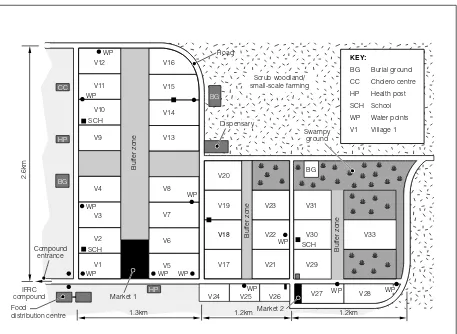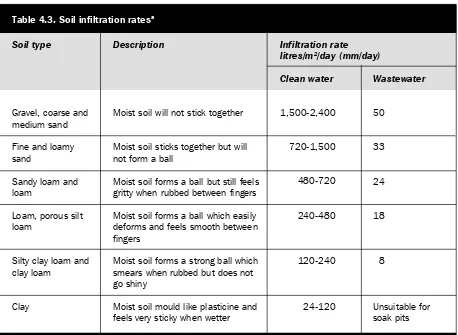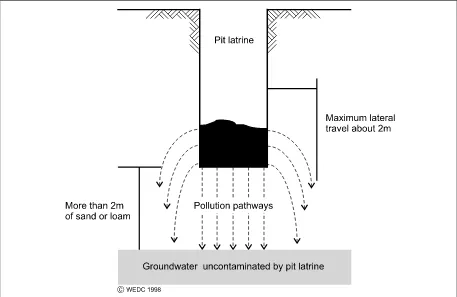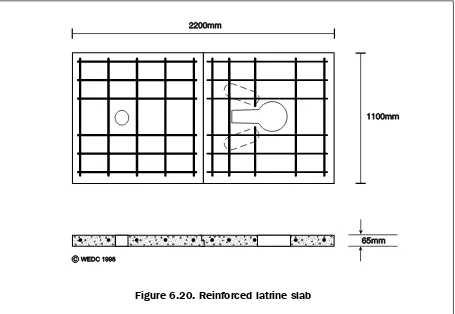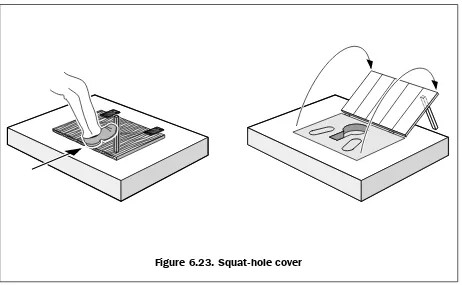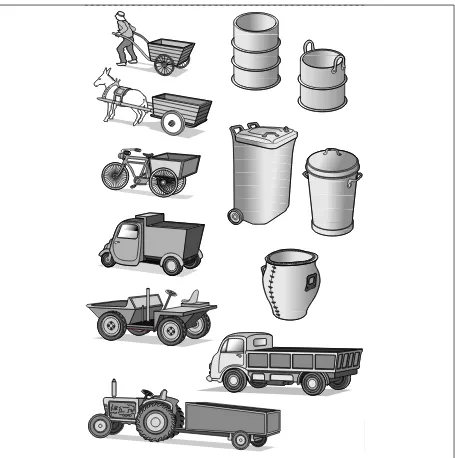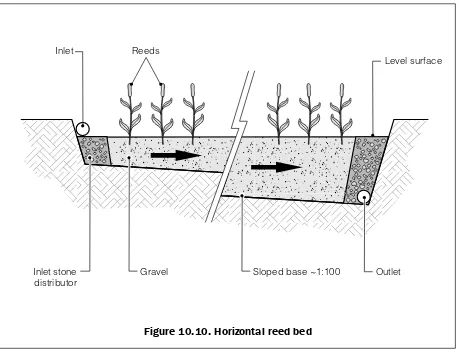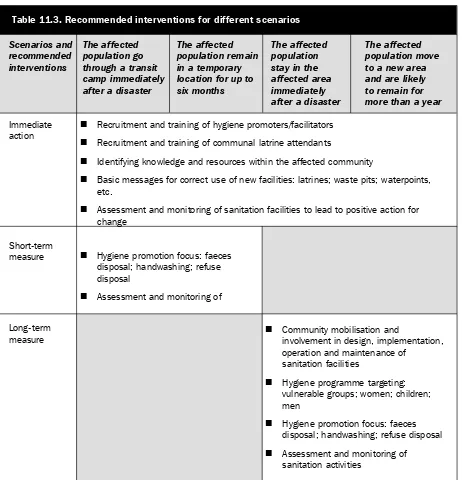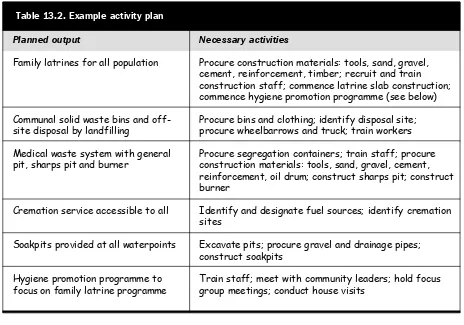iii
!"#"$%&'$(")*%+,-$'.%/'0-$1%'23%/,.%4""3
iv
LE11 3TU UK
© WEDC, Loughborough University, 2002
Any part of this publication, including the illustrations (except items taken
from other publications where the authors do not hold copyright) may be copied,
reproduced or adapted to meet local needs, without permission from the author/s
or publisher, provided the parts reproduced are distributed free, or at cost and
not for commercial ends, and the source is fully acknowledged as given below.
Please send copies of any materials in which text or illustrations have been used to
WEDC Publications at the address given above.
A reference copy of this publication is also available online at:
http://www.lboro.ac.uk/wedc/publications/es.htm
Harvey, P.A., Baghri, S. and Reed, R.A. (2002)
Emergency Sanitation: Assessment and programme design
WEDC, Loughborough University, UK.
ISBN Paperback 1 84380 005 5
This document is an output from a project funded by the UK
Department for International Development (DFID)
for the benefit of low-income countries.
The views expressed are not necessarily those of DFID.
v
Peter Harvey is a Research Associate at the Water, Engineering and
Develop-ment Centre (WEDC). He has worked as a public health engineer on emergency
water supply and sanitation (watsan) programmes in Africa, Asia and Eastern
Europe. He also has experience of rural water supply and sanitation projects in
low-income countries. His major interests include groundwater development and
the sustainability of water and sanitation projects.
Sohrab Baghri is a civil engineer with over fifteen years experience of water
supply and sanitation projects in Africa, Asia and the Middle East. He has worked
on both emergency and long-term development programmes with a wide range of
international aid agencies. His interests include water treatment, environmental
sanitation and watsan facilities for children and disabled people. He is now Water
and Sanitation Adviser at Plan International’s headquarters.
Bob Reed is a Senior Programme Manager at WEDC. He specialises in water
supply and sanitation for rural areas, low-income urban communities and
refu-gees. He has considerable experience of training, design and project
implementa-tion in the Pacific, the Caribbean, Asia and Africa. In recent years he has focused
on the provision of improved and sustainable water supply and sanitation systems
for displaced populations.
The authors would like to hear from anyone who uses this book in the field with
comments on its usefulness and areas which require improvement. Please
for-ward comments or suggestions to Bob Reed at the address overleaf.
Sohrab Baghri
Bob Reed
vi
Water, Engineering and Development Centre
Loughborough University
Leicestershire
LE11 3TU UK
Phone: +44 1509 222885
Fax: +44 1509 211079
Email: WEDC@lboro.ac.uk
http://www.lboro.ac.uk/wedc/
The Water, Engineering and Development Centre (WEDC) is concerned with
education, training, research and consultancy for improved planning provision
and management of physical infrastructure and services for development in
low-and middle-income countries, focusing on the needs low-and demlow-ands of the poor.
vii
The ‘Assessment and Programme Design for Emergency Sanitation’ project
(R6873) has been funded by the Department for International Development
(DFID) of the British Government.
The following organisations have acted as peer reviewers for this research
con-tract. They have reviewed draft documents, provided access to staff for interview,
given advice on project design and implementation, provided information, and
have been involved in and provided support for field trials. This project would not
have been possible without their support and encouragement.
Opinions noted within these documents do not necessarily represent those of
DFID or the collaborators, but are solely those of the authors.
UNITED NATIONS HIGH COMMISSIONER FOR REFUGEES
DR
!
!
!
!
!
P
Development through ResourceOrganisation and Planning
International Federation of Red Cross and Red Crescent Societies
viii
Thanks go to all individuals and organisations that have been involved in the
production of the manual, guidelines and training modules. It is hoped that the
wide range of organisations and individuals that have contributed to this project
will facilitate the usefulness of this work to an even wider range of personnel and
emergency situations.
All contributions are gratefully acknowledged. It should be noted, however, that
the opinions in this document are solely those of the authors. The following
individuals have contributed to the research either as peer reviewers, advisory
panel members, by testing the work in the field, or by providing information for
specific sections of the work.
Peer reviewers
DFID
Department for International Development, UK
John Adams
Bioforce/Trinome, France
Ben Fawcett
IIDS, Southampton, UK
Joy Morgan
Independent Consultant, UK
Rutger Verkerk
MSF, Amsterdem, Holland
Advisory panel members
Astier Almedom
ex-LSHTM, London, UK
Andy Bastable
OXFAM, Oxford, UK
Murray Biedler
MSF, Brussels, Belgium
Dixon Chanda
ex-MSF, Amsterdam, Holland
Riccardo Conti
ICRC, Geneva, Switzerland
Ulrich Jaspers
IFRC, Geneva, Switzerland
Ajeet Oak
DROP, Pune, India
Claude Rakotomalala
UNHCR, Geneva, Switzerland
ix
Raissa Azzalini
MSF, Burundi
William Corkill
IFRC, Nairobi, Kenya
Jean-Michel Detre
MSF, Burundi
Shemeles Gebeyehu
MSF, Kala, Zambia
Julius Kibassa
TRCS, Lugufu, Tanzania
Peter Maes
MSF, Brussels, Belgium
Radjabu Mavlidi
MSF, Burundi
Qumrun Nahar
UNICEF, Bangladesh
Joseph Ng’ambi
MSF, Kala, Zambia
Deo Ntahonsigaye
MSF, Burundi
Gorik Ooms
MSF, Burundi
Samuel Phiri
MSF, Kala, Zambia
Veronique Ridel
MSF, Burundi
Hans Van Dillen
MSF, Lusaka, Zambia
xi
30)#$)#9
<=<>?'(2$%*$)@:'9")+#"#+0)'2")5"/
<A=BC?'D5+,$/+)$9'E0%'"99$992$)#'"),',$9+*)
3"9$'9#5,:
F+7/+0*%"16:
xiii
Glossary of terms
xix
List of figures
xx
List of tables
xxii
MANUAL
Chapter 1. Introduction
1
1.1
About this book
1
1.2
What is emergency sanitation?
2
1.3
Approach to sanitation programmes
3
1.4
People
5
Chapter 2. Is intervention necessary?
7
2.1
Criteria for intervention
7
2.2
Population and health
8
2.3
Assessing the need for intervention
11
Chapter 3. Principles of assessment
13
3.1
Assessment steps
13
3.2
Who should be involved in assessments?
15
3.3
Data collection
15
3.4
Equipment
16
3.5
Background information
16
3.6
Observation (visual assessment)
17
3.7
Mapping
17
3.8
Surveys
18
3.9
Interviewing
18
3.10
Group discussion (focus groups)
19
3.11
Measuring
19
3.12
Counting and calculating
19
3.13
Assessment reports
20
Chapter 4. Background information
21
4.1
General information
21
4.2
Demographic data
22
4.3
Physical features
24
xiv
5.2
Excreta disposal
32
5.3
Solid waste management
36
5.4
Waste management at medical centres
40
5.5
Disposal of dead bodies
44
5.6
Wastewater management
48
5.7
Hygiene promotion
52
Chapter 6. Excreta disposal
57
6.1
Associated risks
57
6.2
Selection criteria for excreta disposal
58
6.3
Communal or family latrines?
62
6.4
Immediate measures
63
6.5
Technology choice: Longer term intervention
68
6.6
Strategies for difficult conditions
78
6.7
Intervention levels
86
6.8
Design and construction
88
6.9
Emptying pits
101
Chapter 7. Solid waste management
105
7.1
Associated risks
105
7.2
Sources and types of solid waste
106
7.3
Initial steps
109
7.4
Key components of solid waste management
110
7.5
On-site disposal options
111
7.6
Transportation options
114
7.7
Off-site disposal options
116
7.8
Intervention levels
118
7.9
Protective measures
119
Chapter 8. Waste management at medical centres
121
8.1
Types and sources of medical waste
121
8.2
Associated risks
122
8.3
Minimising risks
124
8.4
Segregation, storage and transportation
125
8.5
Disposal technology choices
127
8.6
Intervention levels
131
8.7
Education and training
132
xv
9.4
Mortuary service and handling of the dead
138
9.5
Burial
139
9.6
Cremation
140
9.7
Key recommendations for the disposal of the dead
140
Chapter 10. Wastewater management
143
10.1
Associated risks
143
10.2
Sources and types of wastewater
144
10.3
Selection criteria
144
10.4
Technology choice
146
10.5
Wastewater treatment
155
10.6
Cholera treatment centres
161
10.7
Rainfall runoff
161
Chapter 11. Hygiene promotion
163
11.1
Hygiene and health
163
11.2
Definition of hygiene promotion
164
11.3
Focus of hygiene promotion in emergencies
164
11.4
Key principles of hygiene behaviour
165
11.5
Staff
167
11.6
Women, men and children
168
11.7
Hygiene promotion actions
169
11.8
Intervention levels
172
11.9
Key indicators for hygiene practice
173
11.10 Key indicators for programme implementation
174
11.11 Relationship with other aspects of sanitation
174
Chapter 12. Community participation
177
12.1
What is meant by community participation?
177
12.2
Stakeholder analysis
179
12.3
Gender and vulnerable groups
181
12.4
Participation matrix
181
12.5
Community mobilisation
182
12.6
Participatory appraisal techniques
183
12.7
Problem-tree analysis
185
xvi
13.2
The Logical Framework
190
13.3
Activity plan
192
13.4
Programme Gantt chart
193
13.5
Personnel
194
13.6
Implementation plan
195
13.7
Costs and budget
195
13.8
Proposal writing
198
Chapter 14. Implementation
199
14.1
Implementation framework
199
14.2
Staff
199
14.3
Materials and equipment
200
14.4
Finances
201
14.5
Time
202
14.6
Outputs
202
14.7
Community
203
14.8
Information
203
14.9
Programme management
204
14.10 Monitoring and evaluation
206
14.11 Monitoring methods
207
14.12 Evaluation
211
14.13 Report writing
213
GUIDELINES
Chapter 15. Instructions for use
217
15.1
About these Guidelines
217
15.2
Approach
218
15.3
Guideline user group
219
15.4
Relationship between emergency sanitation and other
activities
220
15.5
Time targets
220
15.6
Instructions for use
220
Chapter 16. Rapid assessment and priority setting
223
16.1
Is intervention appropriate?
223
16.2
Assessment process
223
16.3
Getting started
225
16.4
Data collection
225
16.5
Data analysis
234
xvii
17.4
Comparison with current practice
259
17.5
Outline programme proposal
260
17.6
Approval of programme and budget
260
Chapter 18. Immediate action
263
18.1
Objective of immediate action
263
18.2
Action selection process
263
18.3
Relationship with longer-term activities
265
Chapter 19. Detailed programme design
267
19.1
Design process
267
19.2
Stakeholder analysis
268
19.3
Gender and vulnerable groups
269
19.4
Community participation
269
19.5
Baseline survey
270
19.6
Necessary action selection
272
19.7
Selection checklist
276
19.8
Developing the logical framework
277
19.9
Developing the programme activity plan
277
19.10 Developing the time frame for the activity plan
277
19.11 Determining responsibilities
278
19.12 Determining resources
279
19.13 Preparing the budget
280
19.14 Feedback and refinement of plan of action
280
19.15 Final programme proposal and approval
281
Chapter 20. Implementation
283
20.1
What is implementation?
283
20.2
Implementation planning
284
20.3
Implementation framework
286
20.4
Implementation management
288
20.5
Monitoring
289
20.6
Evaluation
290
CASE STUDY
Case study: Kala Camp, Luapula, Zambia
293
Bibliography
349
xviii
CDC
Centres for Disease Control
DFID
Department for International Development (UK)
DROP
Development for Resource Organisation and Planning
ICRC
International Committee of the Red Cross
IFRC
International Federation of Red Cross and Red Crescent Societies
LSHTM
London School of Hygiene and Tropical Medicine
M&E
Monitoring and evaluation
MSF
Médecins Sans Frontières
NGO
Non-governmental organisation
O&M
Operation and maintenance
PAHO
Pan American Health Organisation
PHAST
Participatory Hygiene and Sanitation Transformation
PRA
Participatory rural appraisal
RRA
Rapid rural appraisal
SWOT
Strengths, weaknesses, opportunities, threats
TRCS
Tanzania Red Cross Society
TSS
Total suspended solids
UNCHS
United Nations Centre for Human Settlements (Habitat)
UNHCR
United Nations High Commissioner for Refugees
UNICEF
United Nations Children’s Fund
uPVC
unplasticised polyvinyl chloride
VIP
Ventilated improved pit (latrine)
WEDC
Water, Engineering and Development Centre
xix
Closed setting:
affected site has clear boundaries and population figures
are known (e.g. refugee camp)
Epidemic:
the appearance of a particular disease in a large number of
people in the same period of time
Faecal–oral:
disease transmission from faeces to the human digestive
system via the mouth
Gender:
the physical and/or social condition of being male or
female
Infiltration:
the absorption of liquid by material, for example when
water is absorbed by the ground
Landfilling:
the disposal of solid waste by excavating a hole in the
ground, filling this with waste and then covering with soil
to fill the hole
Latrine:
a toilet, especially a simple one such as a hole in the
ground
Logistics:
the careful organisation of procurement, transportation,
storage and distribution of materials and equipment
Morbidity:
the number of cases of a particular disease reported within
a particular society and within a particular period of time
Mortality:
the number of deaths within a particular society and within
a particular period of time
Open defecation:
to defecate outside a latrine, normally in a natural
environment
Open setting:
affected site has no clear boundaries such as a normal
urban or rural area
Sludge
the build up in volume of excreta, normally within a
accumulation:
latrine pit or septic tank
Socio-cultural:
relating to the social and cultural practices, beliefs and
traditions within a particular society
Stakeholder:
a person or group of people who have a share or a personal
or financial involvement in a programme
Superstructure:
the part of a building which is above the ground
Sustainability:
the ability of something (e.g. activity, facility or system)
to keep operating effectively without negative impact
Vector:
an insect or animal which carries a disease from one animal
or plant to another (particularly humans)
xx
1.1:
Approach to emergency sanitation programmes
4
2.1:
Causes and transmission routes of environmental-related diseases
9
3.1:
Assessment steps
14
4.1:
Sketch map of the affected area
25
4.2:
Sketch map of dwelling area
26
6.1:
Transmission of disease from faeces
58
6.2:
Open defecation field
64
6.3:
Trench defecation field
65
6.4:
Shallow family latrine
66
6.5:
A simple pit latrine
68
6.6:
Deep trench latrines
69
6.7:
Ventilated improved pit latrine
71
6.8:
Cross-section of a typical water-seal pan
72
6.9:
Pour-flush latrines
72
6.10: Overhung latrine
73
6.11: Borehole latrine
75
6.12: Temporary toilet block over existing sewer
77
6.13: Pollution from a pit latrine above the water table
78
6.14: Raised twin-pit ventilated latrine
80
6.15: Sand-enveloped pit
80
6.16: Double vault composting latrine
82
6.17: Wastewater treatment using a septic tank
83
6.18: Aqua privy
85
6.19: Cross-section of latrine slab with footrests
90
6.20: Reinforced latrine slab
91
6.21: Domed pit slab
92
6.22: Wood and mud latrine slab
92
6.23: Squat-hole cover
94
6.24: Stress concentrations on rectangular and circular pits
95
6.25: Shallow pit with lining
97
6.26: Vacuum tanker emptying latrine pit
101
xxi
7.5:
Emptying a cart at a transfer station
116
7.6:
Simple landfilling
117
8.1:
Categories of waste from medical centres
122
8.2:
Sharps container
126
8.3:
Temporary drum incinerator
128
8.4:
Permanent incinerator
129
8.5:
Sharps pit
130
10.1: Wastewater treatment by soil
147
10.2: Unlined soakpit
148
10.3: Soakpit lined
149
10.4: Section through an infiltration trench
151
10.5: Evaporation pan
153
10.6: Evapotranspiration bed
154
10.7: Grease trap
156
10.8: Settlement tank
157
10.9: Tank inlet and outlet pipe
158
10.10: Horizontal reed bed
159
10.11: Vertical reed bed
160
12.1: Problem-tree analysis example
186
12.2: Objectives-tree analysis example
187
15.1: Stages in emergency sanitation programme design
218
16.1: Assessment process
224
16.2: Priority-setting flow chart
253
17.1: Outline design process
258
18.1: Immediate action process
264
19.1: Detailed design process
268
xxii
2.1:
Sanitation-related diseases, causes and transmission routes
8
2.2:
Approximate threshold levels for mortality
11
3.1:
Assessment equipment
16
4.1:
Assessment cover page
22
4.2:
Demographic profile
23
4.3:
Soil infiltration rates
27
5.1:
Recommended minimum objectives for safe excreta disposal
32
5.2:
Recommended minimum objectives for solid waste management
36
5.3:
Recommended minimum objectives for waste management
at medical centres
40
5.4:
Recommended minimum objectives for the disposal of dead bodies
44
5.5:
Recommended minimum objectives for wastewater management
48
5.6:
Recommended minimum objectives for hygiene promotion
52
6.1:
Advantages and disadvantages of communal and family latrines
62
6.2:
Recommended interventions for space of more than 30m
2per person 86
6.3:
Recommended interventions for space of 20-30m
2per person
87
6.4:
Recommended interventions for space of less than 20m
2per person
87
6.5:
Spacing for steel reinforcing bars in pit latrine slabs
91
6.6:
Lining requirements for different soil types
96
6.7:
Suggested maximum sludge accumulation rates
98
6.8:
Recommended septic tank retention times
99
6.9:
Value of sludge digestion factor ‘F’
100
7.1:
Recommended interventions for different scenarios
119
8.1:
Risks, pathways and hazards of medical waste
123
8.2:
Segregation categories
125
8.3:
Recommended interventions for different scenarios
132
10.1: Sizes of settlement tanks
143
11.1: The effects of hygiene practice on diarrhoeal disease
164
11.2: Focus group discussion agenda
170
xxiii
13.1: Generalised logical framework
190
13.2: Example activity plan
192
13.3: Example Gantt chart
193
13.4: Example human resource plan
194
13.5: Example implementation plan
195
13.6: Example sanitation budget
196
14.1: Implementation by milestones
205
14.2: Monitoring framework
208
14.3: Log-frame analysis example
209
14.4: Checklist analysis table
211
14.5: Evaluation framework
212
14.6: Situation report example
214
14.7: Evaluation report outline
215
16.1: Base score definitions
235
16.2: Sector analysis results
251
16.3: Assessment summary
252
16.4: Intervention levels
252
16.5: Recommended intervention levels and scenarios
254
17.1: Structure of outline programme proposal
260
19.1: Stakeholder analysis
269
19.2: Excreta disposal options
273
19.3: Solid waste management options
273
19.4: Waste management options at medical centres
274
19.5: Disposal options for dead bodies
274
19.6: Wastewater management options
275
19.7: Hygiene promotion options
275
19.8: Selection checklist
276
19.9: Logical framework
277
19.10: Example Gantt chart
278
19.11: Implementation plan
279
20.1: Implementation framework
287
!
!
!"#$%&'()
'$()*+%,(-*$
!"!
#$%&'(')*+($%%,
This book has been written to help all those involved in planning and implementing
emergency sanitation programmes. Users may include field technicians, engineers and
hygiene promoters, as well as technical and non-technical staff at agency headquarters.
The authors have attempted to provide a balance between the hardware (technical) and
software (socio-cultural, institutional) aspects of sanitation programmes. It is hoped that this
may help technical staff to understand better the software aspects, and hygiene and
commu-nity health specialists to understand better the more technical aspects.
The main focus of the book is a systematic and structured approach to assessment and
programme design. There is a strong emphasis on socio-cultural issues and community
participation throughout.
!"!"! -'.&/'&.0(%1(')*+($%%,
This book is divided into three main sections:
!
Manual
!
Guidelines
!
Case study
The Manual is designed to act as a textbook which can be referred to for information
regarding minimum objectives, technical options, planning and implementation. Sectoral
chapters do not aim to cover each topic fully but to provide key relevant information for
quick reference. There is a list of further reading material given at the end of each chapter and
a full Bibliography at the end of the book.
The Guidelines are intended for use in the field to conduct rapid assessments, prioritise needs
and design effective relief programmes. Reference is made to the Manual where supporting
information may be required.
.
!
The book is accompanied by an Aide Memoire to Assessment and Design, which is a
summary of the Guidelines process, outlining the key issues and procedures. An electronic
version of the book is available on CD.
!"!"2 3%4(567(4)06('%(&+0(')*+($%%,
This book is not designed to be read from beginning to end. The Manual may be used as a
reference text and hence can be ‘dipped into’ at any point. The Guidelines, however, have
been developed as a complete process and each Chapter represents a specific activity in
assessment and design.
The material in the book has been designed so as to be applicable to sanitation programmes
responding to a wide range of emergency situations including conflict-induced disasters,
famine, floods, earthquakes and cyclones/hurricanes. It should also be suitable for closed
settings, such as large refugee camps, as well as open settings, such as where displaced
people live within a local community and situations where the affected population remains in
a disaster-affected area.
The Manual and Guidelines may be applied to emergency sanitation programmes that last a
few months or several years (see emergency phases below).
!"2
8)5'(*+(090.:06/;(+56*'5'*%6<
Perceptions of what constitutes an ‘emergency’ vary between personnel and between
organi-sations. Generally, an emergency may be considered to be the result of a man-made and/or
natural disaster, whereby there is a serious, often sudden, threat to the health of the affected
community which has great difficulty in coping without external assistance.
!"2"! -'5:0+(%1(56(090.:06/;
An emergency may last a few weeks, several months or years. There are several ways in
which emergencies may be divided into distinct phases (Davis and Lambert, 1996; UNHCR,
2000, etc.). For the purposes of this book an emergency sanitation programme is considered
to consist of three distinct stages:
!
Immediate
!
Short term
!
Long term
/
!
The short-term phase is the period of stabilisation following the immediate phase when the
programme aim is to reduce morbidity and mortality rates (where appropriate) and prevent
any further spread of disease. This phase typically lasts up to six months.
The long-term phase encompasses recovery (or a return to ‘normality’) and settlement where
members of the affected population return to their homes or settle in a new area. During this
phase the primary aim of a sanitation programme is likely to be to sustain the health and
well-being of the affected population, and promote self-sufficiency. This phase may last up to
several years.
!"2"2 8)5'(*+(+56*'5'*%6<
The term ‘sanitation’ is often used and understood by people to refer only to excreta and
wastewater disposal. A WHO Study Group in 1986 defined sanitation as ‘the means of
collecting and disposing of excreta and community liquid wastes in a hygienic way so as not
to endanger the health of individuals and the community as a whole’ (WHO, 1987).
In recent years, however, there has been a growing tendency amongst aid agencies to use the
term ‘sanitation’ to refer to environmental conditions that affect the health of the affected
community. This is often encompassed in the term ‘environmental sanitation’.
For the purposes of this book, ‘emergency sanitation’ is considered to include the following
areas of intervention:
!
Excreta disposal
!
Solid waste management
!
Waste management at medical centres
!
Disposal of dead bodies
!
Wastewater management
!
Hygiene promotion
These sectors are described in detail in Chapters 6-11 of the Manual.
The following definition can be used for emergency sanitation intervention:
Emergency
sanitation intervention is the means of controlling and managing excreta, solid
waste, medical waste, dead bodies, and wastewater, and of promoting best hygiene practice
in order to create a safer environment and minimise the spread of disease in a
disaster-affected area.
!"=
#>>.%5/)('%(+56*'5'*%6(>.%:.5990+
0
!
The implementation stage includes monitoring and evaluation (M&E). In the long term this
process can evolve into the traditional development Project Cycle of assessment, planning
(programme design), implementation and M&E.
The Guidelines are designed to guide the reader through this process to facilitate effective
disaster response programmes. The Manual contains supporting information to assist the
Guidelines process as well as chapters on specific sanitation sectors.
?*:&.0(!"!"(#>>.%5/)('%(090.:06/;(+56*'5'*%6(>.%:.5990+
RAPID ASSESSMENT
AND PRIORITY SETTING
OUTLINE
PROGRAMME DESIGN
IMMEDIATE ACTION
DETAILED
PROGRAMME DESIGN
IMPLEMENTATION
1
!
!"@
A0%>B0
All humanitarian relief programmes should be designed to meet the needs of people who
require assistance and who find themselves in an extraordinary situation in which their lives
have been severely disrupted. For the purposes of this book these people are collectively
referred to as the ‘affected’ community or population. This may include displaced people,
settled people and people living in areas to which displaced people have moved.
!"@"! C%99&6*';(>5.'*/*>5'*%6
Community participation refers to members of the affected population being actively
in-volved in analysing their own problems and needs and those of their community, making
decisions affecting their lives, and implementing appropriate intervention programmes.
Chapter 12 looks at community participation in more detail but it should be considered in all
sections of this book.
!"@"2 D0670.(567(E&B60.5$*B*';
It is essential that any emergency humanitarian programme aims to reach people of both
genders and the most vulnerable people within the affected population. In many emergency
situations in which people have been displaced unaccompanied women make up the vast
majority of the adult population; in other situations there may be large numbers of children or
disabled people. Specific attention is given to the differing needs of men, women and
children throughout this book, as well as to the needs of the sick, disabled and elderly.
F010.06/0+(567(1&.')0.(.057*6:
Adams, John (1999)
Managing Water
Supply and Sanitation in Emergencies. Oxfam:
Oxford.
Davis, Jan and Lambert, Robert (1996) Engineering in Emergencies: A practical guide for
relief workers. RedR / IT Publications: London.
Médecins Sans Frontières (1994)
Public Health Engineering in Emergency Situation.
Médecins Sans Frontières: Paris.
!
"
"
"
"
"
#
!"#$%&'()
)*+,&-./0.&-,1&+&.2.**%/34
The first questions that humanitarian agencies should ask themselves are ‘Under what
conditions is emergency sanitation intervention necessary?’ and ‘Should we intervene in this
particular situation?’.
!"#
$%&'(%&)*+,%*&-'(%.(-'&,-There are several factors which are likely to influence where and when an agency decides to
intervene. These include the:
!
capacity of the affected population;
!political situation;
!
security situation;
!access to area;
!
current health of the affected population; and
!potential health risks to the population.
The vast majority of emergencies worldwide receive no external assistance and are dealt with
by the affected population themselves. In general, where there is existing capacity to do this,
external agencies should not interfere. In some cases, however, there is limited capacity
among the population and a great need for external assistance.
Assuming external assistance is required, the political context will have a major influence on
where agencies are able work or decide to intervene. In general, it is impossible to operate in
an area in which the government does not welcome, or at least tolerate, the presence of aid
agencies.
Security and access are also important factors, as agencies are responsible for the safety and
well-being of their own staff as well as those they are trying to assist. Insecure
conflict-affected areas may be too dangerous to work in, or access to these areas may be extremely
hazardous or even impossible.
pro-5
#
gramme should be to sustain or improve the overall health status and well-being of the
affected population. Many diseases that occur after disasters are linked to poor sanitation and
hygiene practice, so it is essential that sanitation is given as much priority as ‘traditional’
humanitarian interventions such as healthcare, food provision and water supply.
!"!
/,012)'&,-*)-3*4()2'4
!"!"#
5&-67*8('9((-*3&7()7(*)-3*7)-&')'&,-Not all diseases that occur during emergencies are directly sanitation-related. Common
causes of death in young refugee children are malaria, diarrhoea, pneumonia and
malnutri-tion. Whilst diarrhoea and malaria can be sanitation-related, generally pneumonia and
malnutrition are not. However, although malnutrition is not directly sanitation-related, it is
often related to persistent and repeated diarrhoeal infection. It should also be noted that the
affect of diarrhoea on severely malnourished children is normally more severe than on
healthy children, and may be fatal. The importance of sanitation and hygiene is therefore
far-reaching.
The diseases in Table 2.1 are considered to be directly sanitation-related. It should be noted
that this is not an exhaustive list of sanitation-related diseases and does not include illnesses
directly related to water supply.
:)82(*!"#"*;)-&')'&,-<%(2)'(3*3&7()7(7=*>)17(7*)-3*'%)-7?&77&,-*%,1'(7
!"#$%#$
@)(>)2<,%)2*3&7()7(7 *+#''",&#
-,./01,'2
3#4+55#'6(067&/%&'6(87"+9&55,7+7: ;&$#%+%+7
;6&-*)-3*(A(*&-+(>'&,-7 <4#=+&7(#/0(,%"&'(7>+/(0+7&7 ?6&(+/@&4%+,/7
;,&2<8)7(3*3&7()7(7 ;,,>1,'2
B,3(-'<%(2)'(3*3&7()7(7 A6$".7
B5#9.&
C)'(%<%(2)'(3*3&7()7(7 C#5#'+#
*&/9.&(@&D&'
&%'#$#(%)*(+,%)#-"##".)(,.'+$#
!,/%#4%(1+%"(@#&4&7
E#4>(,@("#/01#7"+/9(#@%&'(0&@&4#%+,/(#/0(=&@,'&(@,,0 $'&$#'#%+,/
F5+&7
C+%&7
B,,'($&'7,/#5("69+&/&
G/0+74'+2+/#%&(0&@&4#%+,/ H#5>+/9(+/(=#'&(@&&%
-,0&/%7(#%%'#4%&0(=6(7,5+0(1#7%& F5I(5+4&I(2+%&7
C,7J.+%,&7
6
"
"
"
"
"
#
"7
#
In addition, contaminated medical waste can transmit highly infectious diseases such as HIV
and Hepatitis.
Figure 2.1 illustrates the causes and transmission routes of environmental-related disease. It
is essential that a public health approach is adopted from the onset of any emergency
sanitation programme. Intervention should be a priority wherever there is a considerable
threat to the health of the affected population.
!"!"! $,22)8,%)'&,-*9&'4*?(3&>)2*7')++
It is important that sanitation programme staff consult with qualified medical staff in the area
to gather health data and interpret these in relation to local conditions.
Morbidity and mortality rates are measured in cases per 10,000 people per day.
Pre-emergency values may be very difficult to determine but may be estimated through interviewing
and the collection of any existing health records. The following health data will be useful (if
available):
Health data
Measured in
cases per 10,000 population per day
1. What are the major sanitation-related diseases among the affected population?
2. What were the major diseases among the affected population before this emergency?
3. What is the crude mortality rate (CMR)?
4. What was the CMR?
5. What are the major diseases among the local population?
Any morbidity figures recorded must be interpreted in relation to local conditions and local
medical advice should be sought where possible. Morbidity data are usually interpreted as a
trend and then described as epidemic (a high incidence of an uncommon disease in the area)
or endemic (a disease that regularly occurs in the area).
By assessing the incidence of various diseases (morbidity rate) during the initial stages, it can
be determined if intervention is appropriate and any improvement or worsening in public
health can then be assessed and monitored. Great care must be taken in the interpretation of
health data, however, since it is very difficult to determine which external variables are
responsible for any apparent change in health, and these may not be directly linked to
sanitation. Information on morbidity and mortality — including seasonal and spatial trends
— should be collated from local health centres or hospitals where possible.
""
"
"
"
"
"
#
for this should be sought within the local environment. Morbidity and mortality rates can also
be determined for different demographic groups within the total affected population in order
to identify those most at risk.
!"!"E $)2>12)'&-D*?,%8&3&'A*)-3*?,%')2&'A*%)'(7
Both morbidity and mortality rates are expressed here in
cases per
10,000 population per
day
. This can be calculated as follows:
Example:
There were 834 cases of malaria for a population of 56,000 in a one month period:
Malaria morbidity rate = 834 x 10,000 = 4.9 cases/10,000/day
56,000 x 30
All such figures should be discussed with medical staff to determine their acceptability in the
current situation.
!"E
F77(77&-D*'4(*-((3*+,%*&-'(%.(-'&,-Intervention may be deemed to be necessary if:
a) the incidence of disease is unacceptably high;
b) the risk of disease is unacceptably high; or
c) the crude mortality rate is unacceptably high.
The crude mortality rate can be viewed in relation to the threshold levels provided below.
C,'=+0+%6K2,'%#5+%6('#%&(L %,%#5(/.2=&'(,@(4#7&7(#2,/9($,$.5#%+,/(M(NOIOOO
%,%#5($,$.5#%+,/(M(/.2=&'(,@(0#67(+/('&4,'0($&'+,0
:)82(*!"!"*F00%,G&?)'(*'4%(74,23*2(.(27*+,%*?,%')2&'A*H)3)0'(3*+%,?*I)6(9&22*)-3*J,%(-=*#KK#L
/"+'%+".)
<%#=5&(#/0(./0&'(4,/%',5
<&'+,.7(7+%.#%+,/
?2&'9&/46(K(P.%(,@(4,/%',5
C#Q,'(4#%#7%',$"&
&,'*$(-.,+%0"+1(,%+$23454442*%1
RN
NS)
)ST
UT
6)+$,7$)+".)(0$7$0
<",'%S%&'2(2+/+2.2(,=Q&4%+D&
G22&0+#%&(2+/+2.2(,=Q&4%+D&
V/#44&$%#=5&
"#
#
!"E"# :4%(74,23*2(.(27
Table 2.2 indicates the threshold levels for crude mortality rate at various stages of an
emergency. These can be related to the recommended minimum objectives (immediate,
short-term and long-term) for sanitation sectors described in Chapter 5. It is proposed that by
the end of the short-term intervention period a stable and controlled situation will have been
achieved. The crude mortality rate can be used as an indicator of the need for sanitary
intervention, this is however only an indicator. If long-term objectives appear to be in place
this should not permit complacency; on-going actions should be undertaken to anticipate and
prevent any degeneration in public health.
Attempts have been made to set similar threshold levels for morbidity rates but this has
proved very difficult since morbidity figures must be viewed in relation to what is normal in
that situation or area.
Where health data are unavailable the decision as to whether to intervene or not must be
based solely on the risk of disease. This requires a rapid assessment of the affected area
(Chapter 16).
B(+(%(->(7*)-3*+1%'4(%*%()3&-D
Hakewill, P.A. and Moren, A. (1991) Monitoring and Evaluation of Relief Programmes
T
ropical Doctor
, Supplement 1, pp 24-28.
!"
!
!
!
!
!
#
#
#
#
#
"
!"#$%&'()
)*+&,+-(./0120%//.//3.&4
This section is designed to describe the methods that can be used in the rapid assessment
process. It does not cover the interactive consultation and community participation methods
that are described in Chapter 12.
!"#
$%%&%%'&()*%)&+%
!5
"
In order to conduct an assessment it is first necessary to collect information or data. This data
then needs to be analysed to determine needs and set priorities.
The assessment process becomes more detailed as the programme develops. In the early
stages assessment is rapid and based on observation and consultation with key informants.
This initial assessment will form the basis for setting immediate priorities but should be
followed up with more detailed assessment during detailed programme design. The detailed
assessment involves much more in-depth consultation with the affected population and other
stakeholders (see Chapter 12).
,-./0&*!"#"*$%%&%%'&()*%)&+%
DATA COLLECTION
Collect background information and key data for each sanitation sector
ANALYSIS
Compare collected data with recommended minimum objectives for each sanitation sector
PRIORITISATION
Set priority sanitation sectors and physical areas, and determine the degree of urgency
!6
!
!
!
!
!
#
#
#
#
#
"
!"1
234*%34/56*7&*-(8458&6*-(*9%%&%%'&()%:
Initial assessments are often conducted by experienced personnel from relief agencies,
especially where external international agencies are involved, but this need not always be the
case. Both rapid and more detailed assessments can be conducted by less experienced
international staff, staff from local agencies and members of the affected community itself.
The Guidelines for rapid assessment and priority setting (Chapter 16) aim to assist less
experienced personnel in conducting initial assessments.
!"!
;9)9*<455&<)-4(
Assessment involves the collection of a variety of information and data. The following
quotes describe key points to remember when undertaking assessments:
!
‘In an emergency you will not be able to collect as much substantive information as you
could in a period of non-emergency.
Information should therefore be collected from as
many different people and sources as possible
to corroborate findings. Be aware of bias
and inaccuracies. Additional data may be collected after decisions have been made for
confirmation’ (House and Reed, 1997).
!
‘It is essential to
understand local political and social structures
and to be aware of
conflicting interests within communities when collecting information. It is best to
cross-check information using different sources. It is also important to discuss the purpose of
the assessment with communities to avoid raising expectations unrealistically’ (Gosling
& Edwards, 1995).
!
‘In carrying out an assessment, the principle should be to collect enough data to
imple-ment an effective response. Time spent collecting unnecessary information is time wasted.
On the other hand, not doing an adequate assessment may lead to much more effort, time
and money wasted on an ineffective response. Focus on the most relevant factors (
the
question ‘so what?’ is a useful test of relevance
- ask it frequently)’ (Davis & Lambert,
1996).
The checklists provided in Chapter 15 of the Guidelines identify the
likely
key
information required.
!
‘Keep good records
of any gathered information and store them in such a way that others
can access them. Information gathering takes time and hence the assessor (or those
following the assessor) should not have to repeat work due to inefficient record keeping’
(House & Reed, 1997).
!7
"
!"=
>?/-+'&()
For most sanitation assessment activities there is not a great deal of equipment required.
However, in conducting rapid assessments some of the following items of equipment may be
useful (Table 3.1).
!"@
A9<B.04/(6*-(C40'9)-4(
Relevant background information can often be collected before departure and en-route (if the
assessor is travelling from outside the affected area), as well as in the affected area itself. It is
often surprising how much information can be gathered in this way. The information
gathered may include maps (topographic, geological, road, hydrogeological, demographic
and rainfall), aerial photographs and satellite images. Attempts should be made to find
previous surveys, studies, reports and policy papers. Information concerning the structure of
national and local government, national policy and capacity to cope with an emergency is
also useful. As is information concerning the capacities and intentions of other agencies
working in the area.
The sources of this background information are varied and include:
!
government departments of donor country;
!
government department of host country;
!
mapping / aerial photograph agencies or specialist shops;
!
satellite image providers;
!
university departments;
!
government embassies;
!
hospitals;
!
local and international NGOs;
!
travel guides, books and journals; and
!
the Internet.
Up-to-date information concerning emergency refugee situations can be found on the Internet
at sites such http://www.reliefweb.int and http://www.unhcr.ch. Some sources, such as
satellite image providers, which usually charge for relevant information may provide this
free-of-charge to non-governmental relief agencies.
D975&*!"#"*$%%&%%'&()*&?/-+'&()
!"#$%&'() ! *+%,-&%&'
!
.+/0#+($/1,%,/2,23(141%&-! !/-$#11(5(6+,2/-&%&'
! 7#$&(-'&
! 9,2&:+&;&+
! <,''/'
! =%'/23($&2>2,?&
! 7/'6"(5(?+#1"+,3"%
! !#+68+#%/'
! !+,$0/#'@
! =$#@&
*+'
<',23(&+&;#%,/2(#0/;&(-(1&#(+&;&+ <',23(+#%,%8@&A(+/23,%8@&(#2@(&+&;#%,/2 7#>,23(3&/3'#$",6#+(0&#',231
<',23(@,1%#26&1(5(@,-&21,/21 !"&6>,23(&+&;#%,/21(#2@(+&;&+1
B&?+&6%,23(182+,3"%(%/(,++8-,2#%&($,%1A(C&++1A(&%6D <8+%,$+&(81&
E21$&6%,23($,%1A(&%6D
!8
!
!
!
!
!
#
#
#
#
#
"
!"E
F7%&089)-4(*G8-%/95*9%%&%%'&()H
Perhaps the simplest way of gathering information is through observation. This method
allows the assessor to record non-verbal behaviour among the affected population, the
physical condition of various sanitation sectors and the characteristics of the surrounding
landscape. It can also explore interactions among the affected population and local residents
or other stakeholders. Images can be recorded by taking photographs or video footage, but
discretion is required, particularly where there are cultural sensitivities concerning
photogra-phy.
!"E"# I&<4((9-%%9(<&
On arrival in the field the first step in assessment is to conduct a rapid reconnaissance of the
affected area. This can be done on foot or with the use of a vehicle depending on the area
concerned, and may be a useful starting point in producing a simple sketch map. Transect
walks can be made through the site to take notes on sanitation facilities and practices and
associated indicators. A huge amount of information can be gathered in this way but care
should be taken not to make sweeping assumptions based on limited observation.
!"E"1 F7%&08-(.*7&398-4/0
It should be noted that observation methods based on people’s behaviour are subjective and
time consuming. They cannot detect what members of the affected population are thinking,
and the presence of an outsider can change the behaviour of those being observed. Care must
also be taken in ensuring that the observer is not seen to notice the wrong thing, and therefore
observations need to be conducted in a comprehensive and systematic manner using
appro-priate checklists.
!"J
K9++-(.
Mapping is a very useful tool in obtaining an overall view of the physical situation. This can
be combined with the observation process by sketching site plans or schematic maps during
the initial reconnaissance. This may be used to record locations of:
!
existing sanitation facilities and practices;
!
key public services and institutions;
!
indiscriminate disposal of excreta, solid and medical waste;
!
standing water;
!
water sources, storage and distribution points; and
!
slopes, drainage and geological features.
Mapping can also be done quickly by community members and/or local staff. This is another
way of stimulating discussion and obtaining information on a wide range of issues from those
present. Maps (no matter how rough) can be very useful in co-ordination and planning
meetings with other individuals, organisations and agencies.
!9
"
!"L
M/08&N%
The term ‘survey’ can be used to refer to an examination of opinions or behaviour made by
asking people set questions. It can also be used to refer to measuring and recording details of
land, or simply to examine something carefully and systematically. Surveys can be used to
collect both quantitative and qualitative information. This may be quantitative data
concern-ing demography, health and geography, or qualitative social data such as community
opin-ions and behaviour. There is a broad range of survey techniques which can be used for
emergency sanitation programmes, including random and selective methods. There are a
number of publications which examine these methods in detail, for details of social survey
methods refer to Nichols (1991).
The use of surveys should be balanced against available time, human resources, logistical
support, and the need for statistical analysis and interpretation of results. Some surveys, such
as land surveys, may require specialists and may not be possible to undertake at the initial
stage of assessment.
!"O
P()&08-&Q-(.
In the immediate rapid assessment stages much information can be gathered through
obser-vation, however it will probably be necessary to interview some groups and individuals.
There are various interview techniques ranging from open-ended discussion with randomly
selected members of the affected population to more directed interviews with key informants
or personnel from NGOs.
In some cases it may help to prepare a standard questionnaire for the use of the assessor. This
method should be used with all sections of society and may give the interviewer a chance to
get more complete information. Furthermore, it may provide an opportunity to clarify any
misunderstandings between interviewer and interviewee. However, there are disadvantages
in using this method in that questions may be biased and respondents may give the answers
that they believe the interviewers want. Care should be taken in conducting interviews; the
assessor should avoid asking leading questions (where the desired answer is obvious) or
restrictive questions (with yes or no answers only).
Interviewees can include:
!
key informants (engineers, health staff etc.);
!
formal leaders; and
!
households and individuals.
Refugee women and children, as well as men, should be questioned. Female translators
should be used where possible in interviewing women, especially in cultures where women’s
contact with men is restricted.
!:
!
!
!
!
!
#
#
#
#
#
"
!"#R S04/+*6-%</%%-4(*GC4</%*.04/+%H
In group discussion the assessor guides conversation among a small group of the community
with common interests. These groups may be of mixed sex and age, although single sex focus
groups may promote greater freedom of expression by participants who may not want to
express their opinion in a mixed group.
Discussions are semi-structured and the assessor will introduce a list of topics to encourage
wider discussion among the group’s members. This will enable the facilitator to learn about
their concerns, opinions, problems, and what they consider to be priorities in the various
sanitation sectors.
Care must be taken during the initial rapid assessment that the expectations of the affected
community are not raised unduly prior to programme approval.
!"## K&9%/0-(.
Measurements can be used to determine quantities such as:
!
available area;
!
latrine superstructure dimensions;
!
quantity of water available for handwashing / anal cleansing;
!
volume of pits;
!
soil infiltration rates; and
!
geographical position.
Measurements are likely to require the data collector to have some skill and experience in
using appropriate instruments. Assessment teams can be trained reasonably quickly for most
measurements, but should be carefully supervised throughout data collection.
!"#1 T4/()-(.*9(6*<95</59)-(.
Many assessment methods involve counting; this could be counting numbers of people,
families, facilities or resources. Time should not be wasted obtaining exact figures in the
early stages of assessment. For example, if refugees are staying in family groups it may be
appropriate to count the number of families. The average family size can then be estimated
using a small sample group and therefore the total population may be estimated.
Alterna-tively, other agencies (e.g. UNHCR) working in the area may have more reliable
demo-graphic figures which can be used.
Many figures obtained in assessments may be more useful expressed as percentages. In order
to calculate percentages the following formula should be used:
#;
"
e.g. If only 2000 people have access to excreta disposal facilities yet the total population is
8000 people, the percentage of people with access to these facilities is:
Percentage = 2000 x 100% = 25%
8000
!"#! $%%&%%'&()*0&+40)%
A brief assessment report should be produced following any rapid or detailed assessment.
This can adopt the following structure:
!
Author, date and location
!
Purpose of assessment
!
Background to situation: social, political, technical, health and environmental
!
Executive summary: synopsis of assessment findings
!
Summary assessment table: sector appraisal scores (see Chapter 16)
!
Brief situation summary for each sanitation sector
!

